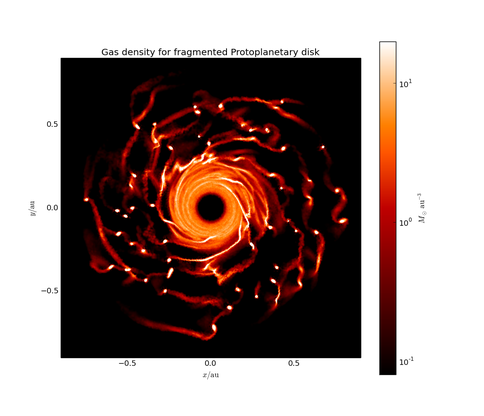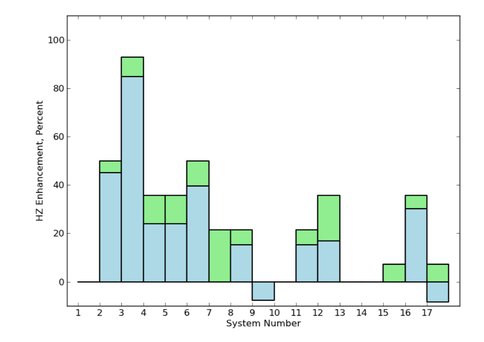2014 Annual Science Report
 VPL at University of Washington
Reporting | SEP 2013 – DEC 2014
VPL at University of Washington
Reporting | SEP 2013 – DEC 2014
Habitable Planet Formation and Orbital Dynamical Effects on Planetary Habitability
Project Summary
This task explores how habitable planets form and how their orbits evolve with time. Terrestrial planet formation involves colliding rocks in a thin gaseous disk surrounding a newborn star and VPL’s modeling efforts simulate the orbital and collisional evolution of a few to millions of small bodies to determine the composition, mass and orbital parameters of planets that ultimately reach the habitable zone. After formation, gravitational interactions with the star and planet can induce short- and long-term changes in orbital properties that can change available energy to drive climate and illuminate the planetary surface. The VPL simulates these effects in known and hypothetical planetary systems in order to determine the range of variations that permit planetary habitability.
Project Progress
Planet Formation and the Effects of Orbital Evolution on the Habitability of Planets and Moons
The VPL made progress on several fronts regarding planet formation of habitable planets. Thomas Quinn and graduate student Isaac Backus have begun supercomputer simulations of planet formation around M dwarf stars, see Figure 1. As large planets in the habitable zone are unlikely to form from local material, these new simulations will reveal how super-Earths can migrate throughout the disk as well as the conditions necessary to “park” terrestrial bodies in the habitable zone (Backus et al., in prep.). Sean Raymond explored the late stages of terrestrial planet formation, including migration of terrestrial planets (Raymond et al. 2013, 2014a, 2014b; Izidoro et al. 2014) water delivery (O’Brien et al. 2014), the composition of the Earth (Jacobson et al. 2014), and the formation of known systems such as Kepler-186 (Bolmont et al. 2014). Sean Raymond also participated in an international forum on the future of exoplanet science, contributing topics related to the origin and formation of habitable planets and the delivery of volatiles (Lammer et al., 2014).
The VPL also made advances in research regarding the role of post-formation orbital evolution of potentially habitable planets. John Armstrong led a paper that studied hypothetical systems with large relative inclinations between orbital planes to show how orbital evolution couples to rotational evolution, which in turn couples to climate evolution (Armstrong et al. 2014). This study revealed that planets that experience strong orbital and rotational evolution can support habitable conditions at larger stellar distances than those without, see Figure 2. An important caveat of this work is that large moons of planets near the outer edge of the habitable zone may be detrimental to habitability as they tend to stabilize the rotational evolution. Graduate student Russell Deitrick and colleagues published a paper that used orbital stability models to reveal the full 3-dimensional orbital architecture of the Upsilon Andromedae system, the first to have the relative orbital planes of two planets directly measured (Deitrick et al. 2015). While this system does not contain any potentially habitable planets, if the large mutual inclination found between two of the giant planets in this system are common then potentially habitable worlds may exist in similar “dynamically-hot” systems in which the potentially habitable worlds orbit would be strongly evolved by its companions. Monika Kress used stability arguments to investigate the plausibility of an Earth-sized planet in the habitable zone of the known multi-planet system Gl 581 (Joiner et al., 2014). Rory Barnes and colleagues discovered that terrestrial exoplanets in mean motion resonances can evolve chaotically for at least 10 Gyr if the orbital planes are non-planar. In some cases orbital eccentricities can grow so large that habitable planets may graze the host star, and hence habitability would be compromised (Barnes et al. 2015, in press).
The VPL also studied the role of tidal evolution of planets and moons in the habitable zones of low-luminosity objects. Rory Barnes showed that tidal theory applied to a large ensemble of transiting planets, i.e. the Kepler data, can reveal the boundary between rocky and gaseous exoplanets (Barnes 2015, in press). Gaseous bodies in the Solar System dissipate energy about 10,000 times less efficiently than rocky bodies, suggesting that similar objects close to stars should circularize at vastly different rates. Thus, constraints on their eccentricities can serve as a proxy for density, and Kepler data can identify the transitional radius, independent of mass measurements. VPL scientists also showed that a wide range of companion properties can sustain modest tidal heating in potentially habitable exoplanets for in excess of 50 billion years, offering a stable energy source that could sustain geochemical cycles conducive to life (van Laerhoven et al., 2014). The VPL has studied the potential habitability of “exomoons,” natural satellites of exoplanets, which may be detectable in the near future. VPL scientists studied the role of tidal heating and the role of planetary radiation on the habitability of exomoons (Heller & Barnes, 2014) and also contributed to an invited review for the Astrobiology Journal (Heller et al. 2014).
This year, Barnes, Dietrick, Luger and Quinn also worked on the development of the VPLanet model architecture, which can calculate the orbital evolution of a planetary system much more quickly than standard N-body algorithms, for modest eccentricities and mutual inclinations. The model also includes obliquity/spin evolution. This new model will allow for efficient calculation of the constraints on planetary orbits for newly discovered systems.
References:
Armstrong, J. et al. (2014) Effects of Extreme Obliquity Variations on the Habitability of Exoplanets. AsBio, 14, 277-291.
Bolmont, E. et al. (2014) Formation, Tidal Evolution, and Habitability of the Kepler-186 System. Astrophys. J., 793, 3.
Deitrick, R. et al. (2015) The Three-dimensional Architecture of the υ Andromedae Planetary System. Astrophys. J., 798, 46.
Heller, R. & Barnes, R. (2014) Constraints on the Habitability of Extrasolar Moons, IAUS 293, 159-164.
Heller, R. et al. 2014, Formation, Habitability, and Detection of Extrasolar Moons, AsBio, 14, 798-835.
Izidoro, A. et al. (2014) Terrestrial Planet Formation in the Presence of Migrating Super-Earths. Astrophys. J., 794, 11.
Jacobson, S. et al. (2014) Highly siderophile elements in Earth’s mantle as a clock for the Moon-forming impact. Nature, 508, 84-87.
Joiner, D. A., Cesar Sul, Diana Dragomir, Stephen R. Kane, Monika E. Kress (2014) “A Consistent Orbital Stability Analysis for the GJ 581 System,” Astrophysical Journal, 788, 160-168 (2014)
O’Brien, D. et al. (2014) Water delivery and giant impacts in the ‘Grand Tack’ scenario. Icarus, 239, 74-84.
Raymond, S.N. et al. (2013) Dynamical and collisional constraints on a stochastic late veneer on the terrestrial planets. Icarus, 226, 671.
Raymond, S.N. et al., (2014) Terrestrial Planet Formation at Home and Abroad. Protostars & Planets VI, 595-618.
Raymond, Sean N. and Cossou, Christophe, 2014, No universal minimum-mass extrasolar nebula: evidence against in situ accretion of systems of hot super-Earths, Monthly Notices of the Royal Astronomical Society, 440, L15
Van Laerhoven, C., Barnes, R., Greenberg, R. (2014) Tides, planetary companions and habitability: habitability in the habitable zone of low mass stars, MNRAS, 441(3), 1888-1898. 10.1093/mnras/stu685
Publications
-
Armstrong, J. C., Barnes, R., Domagal-Goldman, S., Breiner, J., Quinn, T. R., & Meadows, V. S. (2014). Effects of Extreme Obliquity Variations on the Habitability of Exoplanets. Astrobiology, 14(4), 277–291. doi:10.1089/ast.2013.1129
-
Bolmont, E., Raymond, S. N., von Paris, P., Selsis, F., Hersant, F., Quintana, E. V., & Barclay, T. (2014). FORMATION, TIDAL EVOLUTION, AND HABITABILITY OF THE KEPLER-186 SYSTEM. The Astrophysical Journal, 793(1), 3. doi:10.1088/0004-637x/793/1/3
-
Deitrick, R., Barnes, R., McArthur, B., Quinn, T. R., Luger, R., Antonsen, A., & Fritz Benedict, G. (2014). THE THREE-DIMENSIONAL ARCHITECTURE OF THE υ ANDROMEDAE PLANETARY SYSTEM. The Astrophysical Journal, 798(1), 46. doi:10.1088/0004-637x/798/1/46
-
Heller, R., & Barnes, R. (2012). Constraints on the Habitability of Extrasolar Moons. Proceedings of the International Astronomical Union, 8(S293), 159–164. doi:10.1017/s1743921313012738
-
Heller, R., Williams, D., Kipping, D., Limbach, M. A., Turner, E., Greenberg, R., … Zuluaga, J. I. (2014). Formation, Habitability, and Detection of Extrasolar Moons. Astrobiology, 14(9), 798–835. doi:10.1089/ast.2014.1147
-
Izidoro, A., Morbidelli, A., & Raymond, S. N. (2014). TERRESTRIAL PLANET FORMATION IN THE PRESENCE OF MIGRATING SUPER-EARTHS. The Astrophysical Journal, 794(1), 11. doi:10.1088/0004-637x/794/1/11
-
Jacobson, S. A., Morbidelli, A., Raymond, S. N., O’Brien, D. P., Walsh, K. J., & Rubie, D. C. (2014). Highly siderophile elements in Earth’s mantle as a clock for the Moon-forming impact. Nature, 508(7494), 84–87. doi:10.1038/nature13172
-
Joiner, D. A., Sul, C., Dragomir, D., Kane, S. R., & Kress, M. E. (2014). A CONSISTENT ORBITAL STABILITY ANALYSIS FOR THE GJ 581 SYSTEM. The Astrophysical Journal, 788(2), 160. doi:10.1088/0004-637x/788/2/160
-
O’Brien, D. P., Walsh, K. J., Morbidelli, A., Raymond, S. N., & Mandell, A. M. (2014). Water delivery and giant impacts in the ‘Grand Tack’ scenario. Icarus, 239, 74–84. doi:10.1016/j.icarus.2014.05.009
-
Raymond, S. N., & Cossou, C. (2014). No universal minimum-mass extrasolar nebula: evidence against in situ accretion of systems of hot super-Earths. Monthly Notices of the Royal Astronomical Society: Letters, 440(1), L11–L15. doi:10.1093/mnrasl/slu011
-
Raymond, S. N., Kokubo, E., Morbidelli, A., Morishima, R., & Walsh, K. J. (2014). Terrestrial Planet Formation at Home and Abroad. Protostars and Planets VI. doi:10.2458/azu_uapress_9780816531240-ch026
-
Raymond, S. N., Schlichting, H. E., Hersant, F., & Selsis, F. (2013). Dynamical and collisional constraints on a stochastic late veneer on the terrestrial planets. Icarus, 226(1), 671–681. doi:10.1016/j.icarus.2013.06.019
-
Van Laerhoven, C., Barnes, R., & Greenberg, R. (2014). Tides, planetary companions, and habitability: habitability in the habitable zone of low-mass stars. Monthly Notices of the Royal Astronomical Society, 441(3), 1888–1898. doi:10.1093/mnras/stu685
-
PROJECT INVESTIGATORS:
-
PROJECT MEMBERS:
John Armstrong
Co-Investigator
Isaac Backus
Co-Investigator
Russell Deitrick
Co-Investigator
Shawn Domagal-Goldman
Co-Investigator
Monika Kress
Co-Investigator
Rodrigo Luger
Co-Investigator
Victoria Meadows
Co-Investigator
-
RELATED OBJECTIVES:
Objective 1.1
Formation and evolution of habitable planets.
Objective 1.2
Indirect and direct astronomical observations of extrasolar habitable planets.
Objective 3.1
Sources of prebiotic materials and catalysts
Objective 4.3
Effects of extraterrestrial events upon the biosphere




